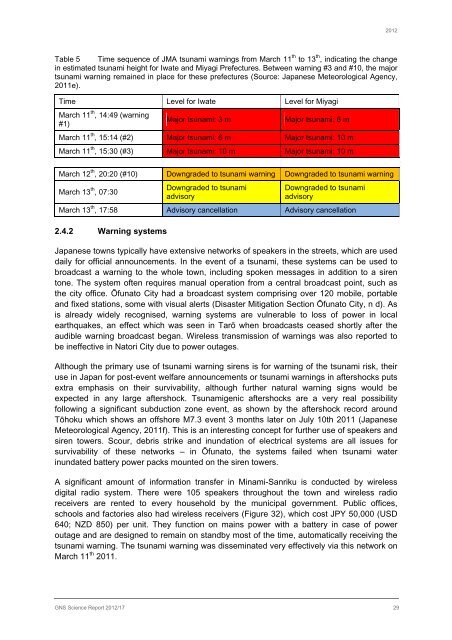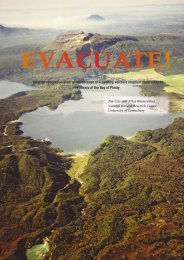Tsunami evacuation: Lessons from the Great East Japan earthquake ...
Tsunami evacuation: Lessons from the Great East Japan earthquake ...
Tsunami evacuation: Lessons from the Great East Japan earthquake ...
You also want an ePaper? Increase the reach of your titles
YUMPU automatically turns print PDFs into web optimized ePapers that Google loves.
2012<br />
Table 5 Time sequence of JMA tsunami warnings <strong>from</strong> March 11 th to 13 th , indicating <strong>the</strong> change<br />
in estimated tsunami height for Iwate and Miyagi Prefectures. Between warning #3 and #10, <strong>the</strong> major<br />
tsunami warning remained in place for <strong>the</strong>se prefectures (Source: <strong>Japan</strong>ese Meteorological Agency,<br />
2011e).<br />
Time Level for Iwate Level for Miyagi<br />
March 11 th , 14:49 (warning<br />
#1)<br />
Major tsunami: 3 m<br />
Major tsunami: 6 m<br />
March 11 th , 15:14 (#2) Major tsunami: 6 m Major tsunami: 10 m<br />
March 11 th , 15:30 (#3) Major tsunami: 10 m Major tsunami: 10 m<br />
March 12 th , 20:20 (#10) Downgraded to tsunami warning Downgraded to tsunami warning<br />
March 13 th , 07:30<br />
Downgraded to tsunami<br />
advisory<br />
Downgraded to tsunami<br />
advisory<br />
March 13 th , 17:58 Advisory cancellation Advisory cancellation<br />
2.4.2 Warning systems<br />
<strong>Japan</strong>ese towns typically have extensive networks of speakers in <strong>the</strong> streets, which are used<br />
daily for official announcements. In <strong>the</strong> event of a tsunami, <strong>the</strong>se systems can be used to<br />
broadcast a warning to <strong>the</strong> whole town, including spoken messages in addition to a siren<br />
tone. The system often requires manual operation <strong>from</strong> a central broadcast point, such as<br />
<strong>the</strong> city office. Ōfunato City had a broadcast system comprising over 120 mobile, portable<br />
and fixed stations, some with visual alerts (Disaster Mitigation Section Ōfunato City, n d). As<br />
is already widely recognised, warning systems are vulnerable to loss of power in local<br />
<strong>earthquake</strong>s, an effect which was seen in Tarō when broadcasts ceased shortly after <strong>the</strong><br />
audible warning broadcast began. Wireless transmission of warnings was also reported to<br />
be ineffective in Natori City due to power outages.<br />
Although <strong>the</strong> primary use of tsunami warning sirens is for warning of <strong>the</strong> tsunami risk, <strong>the</strong>ir<br />
use in <strong>Japan</strong> for post-event welfare announcements or tsunami warnings in aftershocks puts<br />
extra emphasis on <strong>the</strong>ir survivability, although fur<strong>the</strong>r natural warning signs would be<br />
expected in any large aftershock. <strong>Tsunami</strong>genic aftershocks are a very real possibility<br />
following a significant subduction zone event, as shown by <strong>the</strong> aftershock record around<br />
Tōhoku which shows an offshore M7.3 event 3 months later on July 10th 2011 (<strong>Japan</strong>ese<br />
Meteorological Agency, 2011f). This is an interesting concept for fur<strong>the</strong>r use of speakers and<br />
siren towers. Scour, debris strike and inundation of electrical systems are all issues for<br />
survivability of <strong>the</strong>se networks – in Ōfunato, <strong>the</strong> systems failed when tsunami water<br />
inundated battery power packs mounted on <strong>the</strong> siren towers.<br />
A significant amount of information transfer in Minami-Sanriku is conducted by wireless<br />
digital radio system. There were 105 speakers throughout <strong>the</strong> town and wireless radio<br />
receivers are rented to every household by <strong>the</strong> municipal government. Public offices,<br />
schools and factories also had wireless receivers (Figure 32), which cost JPY 50,000 (USD<br />
640; NZD 850) per unit. They function on mains power with a battery in case of power<br />
outage and are designed to remain on standby most of <strong>the</strong> time, automatically receiving <strong>the</strong><br />
tsunami warning. The tsunami warning was disseminated very effectively via this network on<br />
March 11 th 2011.<br />
GNS Science Report 2012/17 29

















